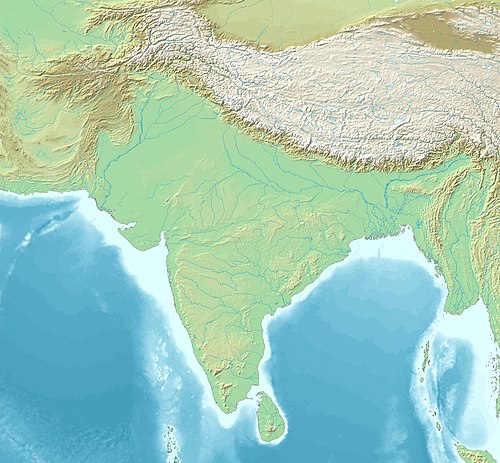Indian subcontinent
Physiographical region in South Asia From Wikipedia, the free encyclopedia
The Indian subcontinent is a physiographic region of Asia below the Himalayas which projects into the Indian ocean between the Bay of Bengal to the east and the Arabian Sea to the west; it is now divided between Bangladesh, India, and Pakistan.[1] Although the terms "Indian subcontinent" and "South Asia" are often also used interchangeably to denote a wider region which includes, in addition, Bhutan, the Maldives, Nepal and Sri Lanka, the "Indian subcontinent" is more of a geophysical term, whereas "South Asia" is more geopolitical.[2] "South Asia" frequently also includes Afghanistan, which is not considered part of the subcontinent even in extended usage.[3]
 Geopolitical coverage of the subcontinent | |
| Area | 4,440,000 km2 (1,710,000 sq mi) |
|---|---|
| Population | c. 1.9 billion |
| Countries | |
| Dependencies | External (1)
|
| Languages | |
| Time zones | List:
|
| Largest cities | |
Name
Summarize
Perspective
Historically, the region surrounding and southeast of the Indus River was often simply referred to as "India" in many historical sources. Even today, historians use this term to denote the entire Indian subcontinent when discussing history up until the era of the British Raj. Over time, however, "India" evolved to refer to a distinct political entity that eventually became a nation-state (today the Republic of India).[4]
According to the Oxford English Dictionary, the term subcontinent signifies a "subdivision of a continent which has a distinct geographical, political, or cultural identity" and also a "large land mass somewhat smaller than a continent".[5][6] Its use to signify the Indian subcontinent is evidenced from the early twentieth century when most of the territory was either part of the British Empire or allied with them.[7][8] It was a convenient term to refer to the region comprising both British India and the princely states.[9][10]
The term has been particularly common in the British Empire and its successors,[11] while the term South Asia is the more common usage in Europe, North America as well as in most country's in South Asia it self some times.[12][13] According to historians Sugata Bose and Ayesha Jalal, the Indian subcontinent has come to be known as South Asia "in more recent and neutral parlance".[14] Indologist Ronald B. Inden argues that the usage of the term South Asia is becoming more widespread since it clearly distinguishes the region from East Asia.[15] While South Asia, a more accurate term that reflects the region's contemporary political demarcations, is replacing the Indian subcontinent, a term closely linked to the region's colonial heritage, as a cover term, the latter is still widely used in typological studies.[16][17]
Since the Partition of India, citizens of Pakistan (which became independent of British India in 1947) and Bangladesh (which became independent of Pakistan in 1971) often perceive the use of the Indian subcontinent as offensive and suspicious because of the dominant placement of India in the term.[18] As such it is being increasingly less used in those countries.[note 7] Meanwhile, many Indian analysts prefer to use the term because of the socio-cultural commonalities of the region.[18] The region has also been called the "Asian subcontinent",[20][21] the "South Asian subcontinent",[22][23][24][25] as well as "India" or "Greater India" in the classical and pre-modern sense.[26][3][27][28]
The sport of cricket, introduced to the region by British colonialism, is notably popular in India, Pakistan, Sri Lanka, Nepal and Bangladesh. Within a cricket context, these countries are sometimes referred to simply as the subcontinent e.g. "Australia's tour of the subcontinent".[29] The term is also sometimes used adjectivally in cricket e.g. "subcontinental conditions".[30][31]
See also
Notes
- Excluding:
- Andaman and Nicobar Islands, close to the Malay Archipelago.
- Ladakh, Spiti, and other areas which lie to the north of the Greater Himalayan Mountain Range.
- Significant portions of northeast India which lie on the Indo-Burman Ranges (spanning Manipur, Nagaland and Mizoram) as well as the Tibetan Plateau (northern Arunachal Pradesh and Sikkim)
- As island countries, Maldives and Sri Lanka are sometimes not considered parts of the subcontinent, as they lack geographic contiguity with the mainland. They are considered parts of the region in cultural geography or geology instead.
- Excluding Upper Mustang and other areas which lie to the north of the Greater Himalayan Mountain Range.
- Excluding:
- Significant landmasses from East Balochistan and Khyber Pakhtunkhwa (like Federally Administered Tribal Areas) which are situated on the Iranian Plateau.
- Parts of Northern Areas (like Baltistan) which lie to the north of the Greater Himalayan Mountain Range (completely crammed towards the Pamir and minuscule fragments of the Hindu Kush northwards from the extreme border end near the Wakhan Corridor of Afghanistan).
- Administered by the United Kingdom, claimed by Mauritius as the Chagos Archipelago.
- Disputed territory with undetermined political status. Administration is split between China (Aksai Chin and the Trans-Karakoram Tract), India (Jammu and Kashmir, and Ladakh), and Pakistan (Azad Kashmir and Gilgit-Baltistan). China claims a small portion of the territory, Pakistan claims the majority of the territory, and India claims the entire territory (see: UN mediation of the Kashmir dispute).
References
External links
Wikiwand - on
Seamless Wikipedia browsing. On steroids.
